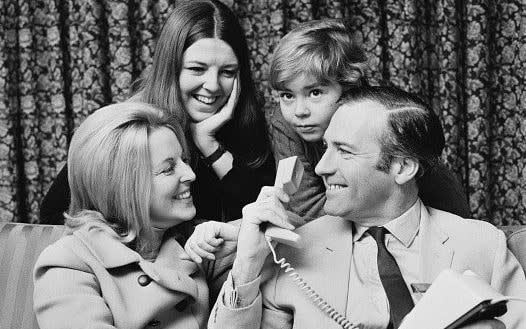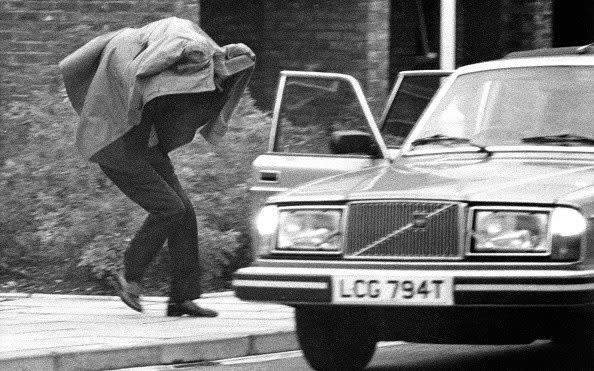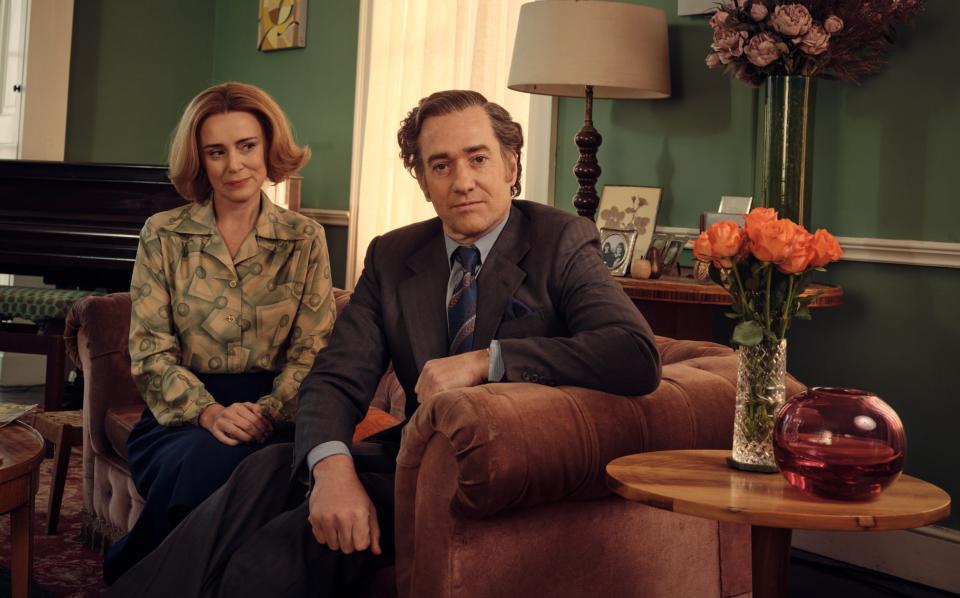Why MP John Stonehouse really faked his own death
- Oops!Something went wrong.Please try again later.
- Oops!Something went wrong.Please try again later.

Mention John Stonehouse to anyone these days and they are apt to look at you blankly. But just occasionally a little light of recognition will go on in their eyes and they will say in a faraway voice, ‘Oh yes… the clothes on the beach.’
In November 1974, Stonehouse, Labour MP for Walsall North and a former Postmaster General in Harold Wilson’s government, carefully placed a pile of his clothes on a Miami beach and went swimming. He never returned. Later that day, a waiter at the hotel found his clothes and alerted the security staff. The police were called, so was the coastguard, and searches were mounted, but there was no sign of him. Stonehouse had disappeared.
In London, the House of Commons stood for a minute’s silence in his memory. Obituaries – generally laudatory in tone – were published. In Walsall, the Labour Party began to prepare for a by-election to fill his now-vacant seat. But not everyone was convinced.
Tony Benn, who had also held the role of Postmaster General, was among those who smelled a rat. ‘People don’t believe he’s dead,’ he wrote in his diary. ‘They think that with the financial trouble he’s in, he’s just disappeared.’ It also seemed a strange coincidence that a few months earlier, Stonehouse had asked the Home Secretary to ‘review arrangements for preventing drowning accidents’.
And then, five weeks later, something happened that not even Tony Benn could have foreseen. Shortly before Christmas, Stonehouse reappeared, very much alive, on the other side of the world – in Melbourne, Australia. But this was only the start of it. In terms of sheer, eye-popping improbability, there turned out to be plenty more where that came from.

As soon became clear, the only reason the Australian police had become suspicious of the Englishman living in a small flat in Melbourne was because they suspected he might be the missing peer Lord Lucan – Lucan had disappeared at the same time as Stonehouse, after murdering his children’s nanny.
Taken to Melbourne police station for questioning, Stonehouse, much to his surprise, was asked to take down his trousers and show his bare legs to the detectives questioning him – Lucan had a distinctive scar on his right thigh. But having established who Stonehouse wasn’t, there was still a good deal of confusion about who he actually was. As well as faking his own death, he had obtained false passports in the names of two of his dead constituents.
If his disappearance hadn’t been dramatic enough, Stonehouse’s reappearance caused a sensation. Nothing quite like it had been seen since the Resurrection, declared the more excitable correspondents covering the case. To ensure that no angle was left unexplored, Fleet Street papers sent reporters off en masse to Australia to cover the story.
Astonishment soon turned to incredulity when Stonehouse tried to explain what had happened. In a letter to the Prime Minister, Harold Wilson, he wrote, ‘My wish was to release myself from the incredible pressures being put on me. Particularly in my business activities and various attempts at blackmail. I considered, clearly wrongly, that the best action I could take was to create a new identity and attempt to live a new life away from these pressures. I suppose this can be summed up as a brainstorm, or a mental breakdown.’ Later, he would refer to his actions as ‘psychiatric suicide’.
No one was sure what to make of this. They were even less sure what to make of it when it turned out that Stonehouse, having left his wife and three children in the UK to mourn his death, had arranged for his young secretary, Sheila Buckley, to fly out and join him. After applying – unsuccessfully – for political asylum in almost every country he could think of, Stonehouse was brought back to England by Scotland Yard detectives to face a series of charges, including fraud and conspiracy to defraud.

His reappearance was to prove a mixed blessing for Harold Wilson. At the time Wilson had a majority of just three and, in theory, needed all the support he could get. In practice, Stonehouse’s claim regarding psychiatric suicide and being reborn with a new personality caused the Labour Party no end of embarrassment. Nor did it help that he insisted on regaling the House of Commons with grindingly long accounts of his mental state, which he blamed in large part on the hypocrisy and humbug he had witnessed among his fellow MPs.
Among those fascinated by the case was the comedian Billy Connolly, who wrote a little ditty about him:
‘John Stonehouse went swimming,
When his bank was a failure.
He jumped in at Miami.
And he swam to Australia.
Some said how clever,
And some said how sinister.
Some said John Stonehouse,
Could have been the Prime Minister.’
It was quite true that some people had marked Stonehouse down as possible Prime Minister material. Born to a working-class family in Southampton, he rose through the ranks of the local Co-operative Society and became an MP at the age of 32. Always ambitious and with a slightly snooty air about him – he had been nicknamed ‘Lord John’ at school – Stonehouse soon made a big impression at Westminster.
For a start, he appeared to be a man of high principles. Unlike many MPs on both sides of the House, Stonehouse was a passionate opponent of apartheid and was deported from Rhodesia for speaking out against white minority rule.
In 1967, he became Minister of State for Aviation, and when he took over as Postmaster General, in 1968, there were plenty of predictions that he could go all the way to the top. It didn’t do his prospects any harm that Stonehouse looked the part. Unlike most male politicians of the day, who resembled grey doughnuts in baggy suits, he was well dressed, an impressive public speaker and, most importantly, came over well on television. Stonehouse’s only serious rival in the Westminster matinee-idol stakes was the then leader of the Liberal Party, one Jeremy Thorpe, who, like him, would soon come a spectacular cropper.

While he may have had a saturnine sort of charm, Stonehouse was hardly sinister. He was, however, a man carrying a huge suitcase of secrets. In 1960, he was recruited as a spy by the Czech secret service. He doesn’t seem to have been much good as a spy and it’s doubtful that he provided his Czech masters with any particularly valuable information. Nonetheless he was happy to take their money and to meet regularly with his ‘handler’ at the Czech embassy. He was also – as far as we know – the only Soviet spy to rise to Cabinet rank.
One of the great ironies of the case is that Harold Wilson, who harboured doubts about Stonehouse without being able to put his finger on why, became convinced there was a Soviet spy in a high government post. For years afterwards, this was reckoned to be an early symptom of Wilson’s dementia. It was only when Stonehouse was revealed to have been a spy in 1980 that it turned out he’d been right.
But Stonehouse’s political career hit a sudden and – as far as he was concerned – unexpected roadblock at the end of the 1960s. Still not sure what it was about him that he found iffy, Wilson decided not to appoint Stonehouse to the Shadow Cabinet after losing the 1970 general election. ‘I always thought he was a crook,’ Wilson said later, which rather begs the question of why he appointed him to high office in the first place.
Almost overnight, Stonehouse found himself in the wilderness. With expensive tastes and three children at private school, he was also running dangerously short of cash. Convinced he had what it took to be a successful businessman, he set up a number of companies. Almost all of them ran rapidly into trouble.
By the beginning of 1974, with his creditors circling, he was becoming desperate. It was then that the seeds of what was by any standards an audacious plan took root in Stonehouse’s mind. The recently released film version of Frederick Forsyth’s bestseller The Day of the Jackal had made him realise how easy it was to obtain a false passport at the time. As there was no correlation between different departments when it came to registering births, marriages and deaths; in effect, all you had to do was find someone who had died without ever possessing a passport.
At this point, we might pause to ask why the 1970s produced so many deeply strange – and dodgy – MPs. Having
written about Jeremy Thorpe in A Very English Scandal, I naively thought that nothing could match him when it came to hatching batty schemes – Thorpe, you may remember, siphoned off £10,000 from Liberal Party funds to pay a hitman to shoot his erstwhile lover, Norman Scott. But in many respects, the Stonehouse story is every bit as bizarre. Once again, you had a charismatic politician becoming involved in a scheme that anyone with the faintest whisper of common sense would realise was pure lunacy.
What on earth got into them, you wonder? How did they ever think they could get away with it? It’s a question I’ve spent many happy hours wrestling with. Had the madness of the times – not so different to our own in terms of frenetic instability – made the participants a little unhinged? Or perhaps the answer is much simpler. Perhaps MPs are always more prone than the rest of us to lose touch with reality. Being at Westminster may encourage them to think of themselves as humble servants of the people, but it also tends to take away any sense of absurdity. The longer they’re there, the less inclined they are to look at themselves in the mirror and think, ‘Am I behaving like a complete idiot?’ Here, readers may wish to doff their caps to the sterling example set in Australia by the former Health Secretary Matt Hancock.
Although I’d always been fascinated by the Stonehouse story, I fought shy of writing a book about it, mainly because it felt like going over old ground. But then the opportunity came up to turn it into a drama series and I found it impossible to resist. In part, this was because writing a script gave me a measure of freedom that I wouldn’t have had with a non-fiction book. Not that I’ve altered the main facts of the case – when real life serves up a story as good as this, it would be ridiculous to monkey about with it. Nor did I want to judge Stonehouse, or to hold him up to ridicule. I just wanted to try to understand him, to find out how he could have got himself into such a pickle.
In this regard, I was extremely lucky that Matthew Macfadyen agreed to play him. Matthew always manages to find the core of humanity in every role, and while viewers may be agog at what Stonehouse gets up to, I hope they will also be rooting for him.
Another unexpected piece of good fortune came my way when Matthew’s wife, Keeley Hawes, happened to pick up one of the scripts and decided she wanted to be in it too – as Stonehouse’s wife, Barbara. Of course, I’m biased, but the fact that the two of them know one another so well gives their scenes together an intimacy and an authenticity I’ve seldom come across.

And what of Stonehouse himself? It would be easy to imagine his story had simply fizzled out after Australia. In fact, his race had several laps left to run. Albeit unwittingly, he was to prove an important, even pivotal figure. After Stonehouse at last resigned as a Labour MP in 1976, the Labour government lost its majority, and was forced into an unofficial coalition with the Liberal Party – the Lib-Lab Pact. During the three years Labour spent limping from one crisis to another, the new leader of the Conservative Party, Margaret Thatcher, was able to establish her authority and to plan what became her general election victory in 1979.
Having left the Labour Party, Stonehouse announced to widespread astonishment that he was joining a tiny fringe group called the English National Party. Very few people had ever heard of the ENP and it was thought at first to have something to do with the ultra-right-wing National Front. Could Stonehouse, the passionate opponent of white rule in Rhodesia, really have thrown in his lot with a bunch of fascists? In fact, the ENP was made up of a harmless group of eccentrics who campaigned on a number of issues, including the abolition of income tax and the importance of teaching morris dancing in English schools. Their leader, a man called Frank Hansford-Miller, later moved to Australia, where he released records of himself playing the didgeridoo under the name ‘Frisky Frank’.
When Stonehouse finally went on trial at the Old Bailey in the spring of 1976, he stood up on the first day and announced that he was dispensing with the services of his lawyers and would be conducting his own defence. Largely as a result of his insistence on contesting every tiny point the prosecution raised, a trial that was scheduled to last three weeks dragged on for over three months.
Found guilty on 18 of the charges he faced, he was sentenced to seven years in prison. In the event, he served three. During his years in prison, Stonehouse passed the time by firing off letters to government ministers on a variety of different subjects, including the amount of money being spent each year on food for police dogs. By the time he emerged in August 1979, the world had moved on. Thatcher was now Prime Minister and Stonehouse, who only 10 years earlier had been flying high, found that he’d become a forgotten figure.
After divorcing Barbara, he married Sheila Buckley and they had a son. At last, it seemed, he had found the peace that eluded him for so long. Sadly, it wouldn’t last. Given everything that had gone before, Stonehouse’s end was to prove peculiarly appropriate. Due to appear on a live television programme about people who had gone missing in unusual circumstances, he suffered a heart attack in his dressing room.
He died three weeks later, on April 14, 1988, at the age of 62. Once again, Stonehouse’s obituaries were published – their tone a little less laudatory than it had been before. And there was one other big difference, of course. This time there was to be no coming back.
Stonehouse will begin on January 2 at 9pm on ITV1

